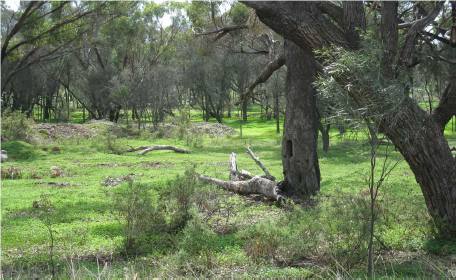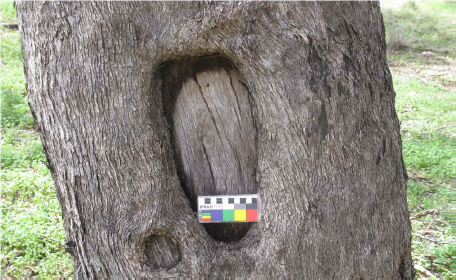As part of the process of re-structuring the Great Northern Highway Intersection in Walebing, 22 km east of Moora CK Maloney Surveying are carrying out 3d laser scanning of the Scar Trees located in the area of the construction site in order to preserve them and provide record to the Heritage Council.


Scarred trees are trees which have had bark removed by Indigenous Australians for the creation of bark canoes, shelters, shields and containers, such as Coolamons. They are among the easiest-to-find archaeological sites in Australia.
Bark was removed by making deep cuts in a tree with a stone pick-axe or other similar tool. The area of bark removed is typically regular in shape, often with parallel sides and slightly pointed or rounded ends, and the scar usually stops above ground level. Australian native Eucalypt species such as box and red gum were commonly used, and the scars remain in trees that are often over 200 years old. It can be rectangular, square, diamond, etc.
Scarred trees are significant evidence of Aboriginal occupation and can provide information on Aboriginal activities in the area that they are located.

You can find scarred trees in Australia even today. Look out for the following characteristics
The Scar is fairly regular in shape, often with parallel sides and slightly pointed or rounded ends.
The Scarring usually begins above ground level.
Exposed sapwood is free of tree knots or branches or there is evidence of a branch having been at the top of the scar.
You may see stone or steel axe cuts at the base and (more rarely) at the top of the scar on the exposed sapwood. Many of these marks are hidden because the bark has since grown back.
The scarred tree is an Australian native species which occurs naturally in the area.
The Aboriginal scarred tree is usually over 200 years old. The older a scar is the more regrowth covers the exposed sapwood, sometimes covering the scar entirelyThe Scar is fairly regular in shape, often with parallel sides and slightly pointed or rounded ends. Exposed sapwood is free of tree knots or branches or there is evidence of a branch having been at the top of the scar.
Of more than 7,500 recorded scar trees across Australia, many are recorded in NSW; but few remain in their original location. Many have been lost through felling, land clearing for agriculture or urban development, occasionally for museum collections, and even to bush fires.
The Walebing Scarred Tree is a York Gum (Eucalyptus loxophleba) that was identified on the west side of Great Northern Highway near the north end of a large parking area opposite the Walebing Roadhouse. The tree is approximately 12 metres tall and approximately 10 metres from the edge of the road.
The Yued Traditional Owners reported that their ancestors would scar trees to sometimes indicate a particular group or site, to obtain material for creating dishes or carrying baskets, or to create a foot or handhold to assist them in climbing a tree. The Walebing Scarred Tree is a site of importance and significance due to its evidence of traditional cultural practices occurring within a known camping and hunting ground. The Yued representatives advised that the scarred tree is important and significant to the Yued people as evidence of their ancestor's occupation of the area.

Walebing was used as a permanent camping area where the Yued live for several generations during the 19th century when Aboriginal people were displaced from their lands and when they were governed under the 1905 Aborigines Act. Moore advises that during the 1920’s and 30’s the reserve became home for hundreds of Yued people that resisted the state governing their lives and that during this period had escaped from Moore River Native Settlement to live with their community at Walebing. Moore documents that many Yued people were born on the reserve and several people and in particular infants were known to have passed away there and have been buried there.
Many Yued people continue to have direct links to the Walebing Reserve from the pre-contact era and contact era. The Yued elders advised that the Walebing Reserve continues to be significant to the Yued Traditional Owners as a place of traditional and historical occupation, and as a place where they continue to visit due to the family connections present.
CK Maloney Surveying are proud to be partnering with Central Earthmoving in this Main Roads WA Project.





Comments